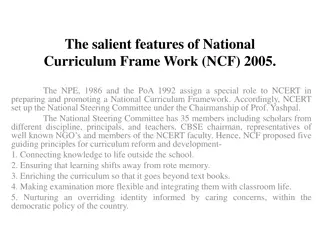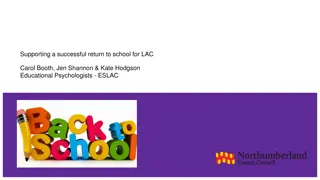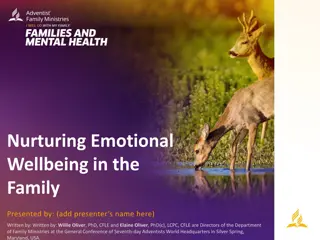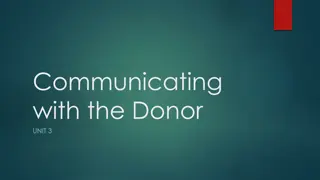Effective Communication in Creating a Nurturing Home Environment
Cultivating a supportive and emotionally nurturing home requires premium conflict resolution communication. The key to successful relationships lies in genuine communication from our inner core, as superficial techniques can lead to misunderstandings. Effective communication involves clear expression of feelings, active listening, and understanding different perspectives. Breakdowns in communication within families can stem from stress, misunderstandings, unresolved issues, lack of self-awareness, beliefs, and emotional intelligence. Recognizing how communication breakdowns manifest - such as yelling, blaming, and verbal abuse - is crucial for fostering a healthy family dynamic.
- Effective Communication
- Nurturing Home Environment
- Conflict Resolution
- Family Dynamics
- Emotional Intelligence
Download Presentation

Please find below an Image/Link to download the presentation.
The content on the website is provided AS IS for your information and personal use only. It may not be sold, licensed, or shared on other websites without obtaining consent from the author. Download presentation by click this link. If you encounter any issues during the download, it is possible that the publisher has removed the file from their server.
E N D
Presentation Transcript
Cultivating a supportive and emotionally Nurturing home Presenters: Laurie Shiell from Centers Against Abuse Sherrie Lynn Lilley, LMHC from Pneuma Counseling and Consulting
CULTIVATING A SUPPORTIVE AND EMOTIONALLY NURTURING HOME REQUIRES: PREMIUM CONFLICT RESOLUTION COMMUNICATION
The most important ingredient we put into any relationship is not what we say or what we do, but what we are. And if our words and our actions come from superficial human relations techniques rather than from our own inner core, others will sense that duplicity. We simply won t be able to create and sustain the foundation necessary for effective interdependence. STEPHEN R. COVEY
COMMUNICATION COMMUNICATION IS HOW WE LEARN ABOUT OTHERS AND TEACH OTHERS ABOUT OURSELVES. IT IS HOW WE INTERACT WITH THOSE AROUND US. ONE OF THE MOST IMPORTANT ASPECTS OF COMMUNICATION IS BEING ABLE TO PRESENT EFFECTIVELY HOW WE FEEL, AS THIS HELPS OTHERS TO UNDERSTAND US BETTER AND VICE VERSA. SPEAKING TRUTHFULLY FOR THE BETTERMENT OF THE RELATIONSHIP EVERYONE WANTS TO BE UNDERSTOOD
COMMUNICATION . . . . . . . . THINK ABOUT WHAT YOU WANT TO SAY. TIPS BE CLEAR ABOUT WHAT YOU WANT TO COMMUNICATE. TALK ABOUT WHAT IS HAPPENING AND HOW IT AFFECTS YOU. USE I STATEMENTS SUCH AS I NEED , I WANT AND I FEEL . ACCEPT RESPONSIBILITY FOR YOUR OWN FEELINGS. LISTEN TO YOUR PARTNER AND OR CHILD. TRY TO UNDERSTAND THEIR INTENTIONS, feelings, needs and wants BE AWARE OF YOUR TONE OF VOICE. NEGOTIATE AND REMEMBER THAT BEING HEARD AND UNDERSTOOD IS BETTER THAN being right all the time
WHAT CAUSES BREAKDOWNS OF COMMUNICATION IN FAMILIES? Stress Misunderstandings Unresolved personal or family issues Lack of self-awareness Blended family dynamics Incompatible beliefs Low emotional intelligence
WHAT are some ways communication breakdowns show up in the family? Yelling Holding Grudges Keeping Secrets Blaming Giving The Silent Treatment Using Ultimatums Or Threats Labeling Someone Bad Instead Of The Behavior Poor Listening Verbal Abuse Blaming Shaming Discouraging Self-Expression
WHAT ARE THE EFFECTS OF THESE BEHAVIORS ON THE FAMILY? Adults live with chronic stress that fosters tension in their relationships and causes feelings of resentment, and disconnection from one another. This in turn, leads Children learn to suppress their thoughts and feelings out of fear of being ignored, dismissed, or accused of being bad, dumb, lazy, selfish, or weak. to conflict.
DISCUSSION QUESTIONS CAN THESE COMMUNICATION TIPS WORK INTERGENERATIONALLY? WHAT IS CONFLICT? CONFLICT IS A SERIOUS DISAGREEMENT OR ARGUMENT. Or Conflict is a silent, internal process in which an individual is contemplating
WHAT HAPPENS IN families when we do not resolve conflict? The stress produced becomes chronic stress and will eventually become toxic stress.
What is Toxic Stress? Toxic Stress can occur when a family is going through a particularly stressful time or has endured serious adversity. This is a concern as the effects can be long-lasting and can potentially impact a child s learning, behavior and health long after childhood.
Conflict Resolution Strategies Acknowledge the conflict. No one enjoys conflict, so it may be tempting to pretend it doesn t exist or will resolve itself, but stating what the family is disagreeing about will open the pathway to a solution. Define the problem. Clarifying the problem is important so that all parties can participate with an understanding of their role in the situation. Meet on neutral ground. Moving the discussion out of the spaces where the arguments happen and where the tension lies clears the air and creates a safe place for all to contribute to the dialogue. Let everyone have a say. Often, conflict is rooted in misunderstanding. Allowing everyone to speak their truth puts all of the issues on the table so that thoughts and feelings can be acknowledged and the family can share in the process of navigating their way to a solution. Note: it is important to establish the rules of the meeting so that everyone is on the same page and the meeting can go smoothly. Embrace the process. Resolving a family conflict takes patience, courage, and flexibility. Family members should be prepared for the discussion to sometimes be very uncomfortable. If children are present, the adults have a responsibility to model emotional intelligence so that the younger ones learn healthy conflict-resolution skills early. Agree on a solution. Agreeing on a solution may not mean that everyone is in full agreement. Sometimes, resolving the conflict means compromise and negotiation, but with a solution that honors the position of all family members. Agreeing to a solution may mean accepting that you may still disagree but not allowing this to negatively impact the family relationships. Determine each side s role in the solution. Family conflict should welcome all involved parties to accept their role in the disagreement and also their role in the solution. What action are they responsible for in ensuring that the conflict is not reactivated?
LETS PRACTICE!
REMEMBER Constant conflict causes an atmosphere of high stress. Highly stressful environments cause adverse effects for all members of the family Unresolved conflict perpetuates maladaptive ways of managing stress which all members of the family live out and even pass on to the next generation. Children can be in stressful situations and be protected from the effects of toxic stress. A loving adult who handles conflict and stress well is better equipped to reduce the impact of toxic stress in children through physical and emotional comfort. The adults in the family must also practice personal wellness and self-care in order to reduce the effects of stress in their lives. This may mean reaching out for their own support. We can then put the child s needs at the center, even while we work to protect ourselves.
CULTIVATING SAFE AND POSITIVE MENTAL HEALTH SPACES FOR THE WHOLE FAMILY DEPENDS ON THE WILLINGNESS OF each member of the household s commitment to staying present and alert to past and current problems. It requires each family member to practice self-care and to recognize that they can protect children from the long-term effects of toxic stress and correct legacies of maladaptive ways of being.























